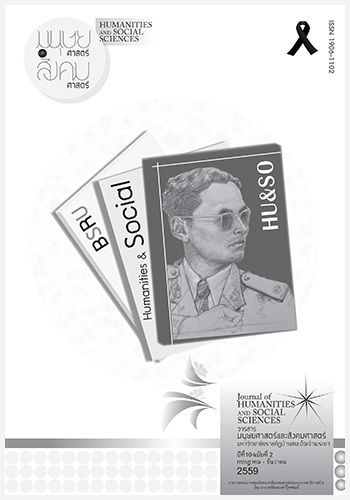The Development of Teaching English Listening and Speaking by Communication Device
Keywords:
Mobile Learning, English Development, English Listening and SpeakingAbstract
This study consists of two objectives: 1) to develop teaching English listening and speaking by communication device and 2) to make an analysis and synthesis in order to obtain a development of teaching English listening and speaking via communication device with mobile learning of university in increasing students’ achievements in the future. The study was conducted by means of documentary research in which the researcher analyzed and synthesized related documents including academic journals, academic conferences both domestic and international documentss from relevant agencies as well as the Internet in order to obtain the knowledge that serves the educational purpose.
The study result can be concluded that the development of teaching English listening and speaking by mobile learning will not only be a new teaching method in accordance with the educational goals and the most effective in the future but it will also be beneficial to students, involved individuals, society and country later on.
References
Bray, E., K. Aoki & L. Dlugosh, (2008). Predictors of learning satisfaction in Japanese online distance learners. Internationnal Review of Research in Open and Distance Learning. 9 (3).
Cohen, A. D. (2012). Strategies : the interface of styles, strategies, and motivation on tasks. Language Learning Psychology : Research, Theory, and Pedagogy. Basingstoke, England : Palgrave Macmillan.
Collis, B. (1996). Tel E-learning in a Digital World : the Future of Distance Learning. London : International Thompson Computer Press.
Crosling, G. & I. Ward. (2002). Oral communication : the workplace needs and uses of business graduate employees. English for Specific Purposes. 21, 41-57.
Dörnyei, Z. (2001). Motivational Strategies in the Language Classroom. Cambridge : Cambridge University Press.
Flowerdew, J. & L. Miller, (2005). Second Language Listening : Theory and Practice. Cambridge : Cambridge University Press.
Grainger, P. R. (1997). Language-learning strategies for learners of japanese : investigating ethnicity. Foreign Language Annals. 30 (3), 378-385.
Griffiths, C. (2003). Patterns of language learning strategy use. System. 31 (3), 367-383.
Harvard Extension School. (2016). Distance Education : Online Courses at Harvard. Retrieved 6 August 2016. From http://www.extension. harvard.edu/distance-education.
Harrison, R. (2002). Wireless learning with eClass2go. Proceedings of the European Workshop on Mobile and Contextual Learning. New York : CRC Press.
Helgesen, M., & S. Brown. (2007). Practical English Language Teaching : Listening. New York : McGraw Hill.
Holme, O. & M. Sharples. (2002). Implementing a student learning organizer on the pocket PC platform. Proceedings of the European Workshop on Mobile and Contextual Learning. London : Fontana.
Koppi, T. (2002). Authentic contextual lifelong learning design. Proceedings of the European Workshop on Mobile and Contextual Learning. New York : Oxford University Press.
Koshy, V. (2005). Action Research for Improving Practice : a Practical Guide. London : SAGE.
Maleki, A. (2007). Teach ability of communication strategies : an Iranian experience. System. 35 (4), 583-594.
Malliou, E., et al. (2002). The AD-HOC project : eLearning anywhere, anytime. Proceedings of the Europeain Workshop on Mobile and Contextual Learning. Thousand Oaks, CA : Sage.
Mitchell, A. (2002). Developing a prototype microportal for m-learning : a social constructivist approach. Proceedings of the European Workshop on Mobile and Contextual Learning. California : Wadsworth.
Noon-ura, S. (2008). Teaching listening speaking skills to Thai students with low english profici. 10 (4), 173-192. Retrieved 22 November 2016. From http://www.asian-efl-journal.com/August_16_sna.php
Oxford, R. L. (1990). Language Learning Strategies. New York : Newbury House/Harper and Row.
Oxford, R. L., R. Lavine & D. Crookal. (1990). Strategy training for language learners : sx situational case studies and a training model. Foreign Language Annals. 23 (3), 197-216.
Pawlak, M. (2011). Research into language learning strategies : taking stock and looking ahead. Individual Learner Differences in SLA. Bristol : Multilingual Matters.
Pearson, E. (2002). Anytime anywhere : empowering learners with severe disabilities. Proceedings of the European Workshop on Mobile and Contextual Learning. San Francisco : Jossey-Bass.
Perry, D. (2002). Wireless Networking in Schools. N.p. : BECTA.
Robinson, P. (1991). ESP Today : a Practitioner’s Guide. London : Prentice Hall / International English Language Teaching.
Zaremba, A. J. (2006). Speaking Professionally. Canada : ThompsonSouth-Western.
Downloads
Published
How to Cite
Issue
Section
License
Copyright (c) 2022 Faculty of Humanities and Social Sciences Bansomdejchaopraya Rajabhat University

This work is licensed under a Creative Commons Attribution-NonCommercial-NoDerivatives 4.0 International License.




